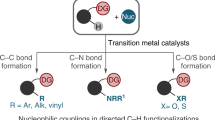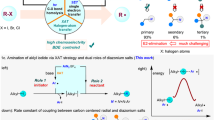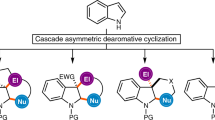Abstract
Since its introduction by Kagan more than 40 years ago, samarium(ii) iodide (SmI2; Kagan’s reagent) has found copious applications in organic synthesis. Its inherent strong reducing ability, together with external additives, enable tunable reactivity and endow SmI2 with powerful reactivity and impressive chemoselectivity. As a result, SmI2 has been broadly applied in a wide range of useful transformations, especially those involving C–C bond formation, in which both radical and ionic pathways could be selectively accessible. In the total synthesis of natural products, the versatility of SmI2 renders it more appealing than other single-electron reductants, particularly when used in key steps at the late stages of synthetic routes. Moreover, its ability to reach previously unattainable C–C bond disconnections accelerates the development of new synthetic strategies. In this Review, we highlight selected examples of SmI2-mediated C–C bond formation in the total synthesis of natural products reported from 2014 to 2021.

This is a preview of subscription content, access via your institution
Access options
Subscribe to this journal
Receive 12 digital issues and online access to articles
$119.00 per year
only $9.92 per issue
Buy this article
- Purchase on Springer Link
- Instant access to full article PDF
Prices may be subject to local taxes which are calculated during checkout








Similar content being viewed by others
References
Namy, J. L., Girard, P. & Kagan, H. B. New preparation of some divalent lanthanide iodides and their usefulness in organic-synthesis. Nouv. J. Chim. 1, 5–7 (1977).
Girard, P., Namy, J. L. & Kagan, H. B. Divalent lanthanide derivatives in organic synthesis. 1. Mild preparation of samarium iodide and ytterbium iodide and their use as reducing or coupling agents. J. Am. Chem. Soc. 102, 2693–2698 (1980).
Shabangi, M. & Flowers, R. A. II Electrochemical investigation of the reducing power of SmI2 in THF and the effect of HMPA cosolvent. Tetrahedron Lett. 38, 1137–1140 (1997).
Flowers, R. A. II Mechanistic studies on the roles of cosolvents and additives in samarium(II)-based reductions. Synlett 10, 1427–1439 (2008).
Shabangi, M., Sealy, J. M., Fuchs, J. R. & Flowers, R. II The effect of cosolvent on the reducing power of SmI2 in tetrahydrofuran. Tetrahedron Lett. 39, 4429–4432 (1998).
Szostak, M., Fazakerley, N. J., Parmar, D. & Procter, D. J. Cross-coupling reactions using samarium(II) iodide. Chem. Rev. 114, 5959–6039 (2014).
Edmonds, D. J., Johnston, D. & Procter, D. J. Samarium(II)-iodide-mediated cyclizations in natural product synthesis. Chem. Rev. 104, 3371–3403 (2004).
Nicolaou, K. C., Ellery, S. P. & Chen, J. S. Samarium diiodide mediated reactions in total synthesis. Angew. Chem. Int. Ed. 48, 7140–7165 (2009).
Li, Z., Nakashige, M. & Chain, W. J. A brief synthesis of (−)-englerin A. J. Am. Chem. Soc. 133, 6553–6556 (2011).
Zi, W., Yu, S. & Ma, D. A convergent route to the Galbulimima alkaloids (−)-GB 13 and (+)-GB 16. Angew. Chem. Int. Ed. 49, 5887–5890 (2010).
Wei, Y., Zhao, D. & Ma, D. Total synthesis of the indole alkaloid (±)- and (+)-methyl N-decarbomethoxychanofruticosinate. Angew. Chem. Int. Ed. 52, 12988–12991 (2013).
Guo, S., Liu, J. & Ma, D. Total synthesis of leucosceptroids A and B. Angew. Chem. Int. Ed. 54, 1298–1301 (2015).
Ni, D., Wei, Y. & Ma, D. Thiourea-catalyzed asymmetric Michael addition of carbazolones to 2-chloroacrylonitrile: total synthesis of 5,22-dioxokopsane, kopsinidine C, and demethoxycarbonylkopsin. Angew. Chem. Int. Ed. 57, 10207–10211 (2018).
Nagaraju, K., Ni, D. & Ma, D. Total synthesis of kopsinitarine E. Angew. Chem. Int. Ed. 59, 22039–22042 (2020).
Gao, Y. & Ma, D. In pursuit of synthetic efficiency: convergent approaches. Acc. Chem. Res. 54, 569–582 (2021).
Procter, D. J. et al. Recent advances in the chemistry of ketyl radicals. Chem. Soc. Rev. 50, 5349–5365 (2021).
Molander, G. A. & Kenny, C. Stereocontrolled intramolecular ketone-olefin reductive coupling reactions promoted by samarium diiodide. Tetrahedron Lett. 28, 4367–4370 (1987).
Molander, G. A. & Kenny, C. Intramolecular reductive coupling reactions promoted by samarium diiodide. J. Am. Chem. Soc. 111, 8236–8246 (1989).
Zhu, L., Luo, J. & Hong, R. Total synthesis of (±)-cafestol: a late-stage construction of the furan ring inspired by a biosynthesis strategy. Org. Lett. 16, 2162–2165 (2014).
Gong, J. et al. Total synthesis of atropurpuran. Nat. Commun. 7, 12183 (2016).
Nie, W. et al. Enantioselective total synthesis of (−)-arcutinine. J. Am. Chem. Soc. 141, 9712–9718 (2019).
Liu, G. et al. Total synthesis of aplykurodinone-1. Org. Lett. 16, 4380–4383 (2014).
Fukuzawa, S., Nakanishi, A., Fujinami, T. & Sakai, S. Reductive coupling of ketones or aldehydes with electron-deficient alkenes promoted by samarium diiodide J. Chem. Soc. Chem. Commun. 624–625 (1986).
Fukuzawa, S., Nakanishi, A., Fujinami, T. & Sakai, S. Samarium(II) diiodide induced reductive coupling of α,β-unsaturated esters with carbonyl compounds leading to a facile synthesis of γ-lactone. J. Chem. Soc. Perkin Trans. 1. 1669–1675 (1988).
Otsubo, K., Inanaga, J. & Yamaguchi, M. SmI2-induced reductive cross-coupling of carbonyl compounds with α,β-unsaturated esters. Tetrahedron Lett. 27, 5763–5764 (1986).
Paterson, I., Xuan, M. & Dalby, S. M. Total synthesis of jiadifenolide. Angew. Chem. Int. Ed. 53, 7286–7289 (2014).
Zhang, Y. et al. Protecting-group-free total synthesis of (−)-jiadifenolide: development of a [4 + 1] annulation toward multisubstituted tetrahydrofurans. Org. Lett. 17, 5480–5483 (2015).
Prasad, E. & Flowers, R. A. Mechanistic impact of water addition to SmI2: consequences in the ground and transition state. J. Am. Chem. Soc. 127, 18093–18099 (2005).
Chopade, P. R., Prasad, E. & Flowers, R. A. The role of proton donors in SmI2-mediated ketone reduction: new mechanistic insights. J. Am. Chem. Soc. 126, 44–45 (2004).
Szostak, M., Spain, M. & Procter, D. J. Ketyl-type radicals from cyclic and acyclic esters are stabilized by SmI2(H2O)n: the role of SmI2(H2O)n in post-electron transfer steps. J. Am. Chem. Soc. 136, 8459–8466 (2014).
Parmar, D. et al. Reductive cyclization cascades of lactones using SmI2–H2O. J. Am. Chem. Soc. 133, 2418–2420 (2011).
Guo, L. et al. Organocatalytic, asymmetric total synthesis of (−)-haliclonin A. Angew. Chem. Int. Ed. 55, 4064–4068 (2016).
Harb, H. Y. & Procter, D. J. SmI2-mediated carbonyl–alkene couplings for the synthesis of small carbocyclic rings. Synlett 23, 6–20 (2012).
Baker, T. M. et al. Synthesis and reactions of the pestalotiopsin skeleton. Angew. Chem. Int. Ed. 47, 5631–5633 (2008).
Chen, J. et al. Synthesis of tricyclo[4,3,1,01,5]decane core of plumisclerin A using Pauson–Khand annulation and SmI2-mediated radical cyclization. Org. Lett. 17, 3379–3381 (2015).
Gao, M. et al. Enantioselective total synthesis of (+)-plumisclerin A. Angew. Chem. Int. Ed. 57, 13313–13318 (2018).
Zhao, N. et al. Total synthesis of astellatol. Angew. Chem. Int. Ed. 57, 3386–3390 (2018).
Su, F. et al. Total synthesis of maoecrystal P: application of a strained bicyclic synthon. Angew. Chem. Int. Ed. 57, 760–764 (2018).
Farney, E. P., Feng, S. S., Schäfers, F. & Reisman, S. E. Total synthesis of (+)-pleuromutilin. J. Am. Chem. Soc. 140, 1267–1270 (2018).
Springer, D. M. et al. Cyclopentanone ring-cleaved pleuromutilin derivatives. Eur. J. Med. Chem. 42, 109–113 (2007).
Turlik, A., Chen, Y., Scruse, A. C. & Newhouse, T. R. Convergent total synthesis of principinol D, a rearranged kaurane diterpenoid. J. Am. Chem. Soc. 141, 8088–8092 (2019).
Classen, M. J. et al. Enantioselective total synthesis of (+)-euphorikanin A. J. Am. Chem. Soc. 143, 8261–8265 (2021).
Leung, J. C. et al. Total synthesis of (±)-phomoidride D. Angew. Chem. Int. Ed. 57, 1991–1994 (2018).
Fukaya, K. et al. Synthesis of paclitaxel. 1. Synthesis of the ABC ring of paclitaxel by SmI2‐mediated cyclization. Org. Lett. 17, 2570–2573 (2015).
Deng, J., Ning, Y., Tian, H. & Gui, J. Divergent synthesis of antiviral diterpenes wickerols A and B. J. Am. Chem. Soc. 142, 4690–4695 (2020).
Nicolaou, K. C., Zhang, H., Ortiz, A. & Dagneau, P. Total synthesis of the originally assigned structure of vannusal B. Angew. Chem. Int. Ed. 47, 8605–8610 (2008).
Breitler, S. & Carreira, E. M. Total synthesis of (+)-crotogoudin. Angew. Chem. Int. Ed. 52, 11168–11171 (2013).
Namy, J. L., Souppe, J. & Kagan, H. B. Efficient formation of pinacols from aldehydes or ketones mediated by samarium diiodide. Tetrahedron Lett. 24, 765–766 (1983).
Souppe, J., Danon, L., Namy, J. L. & Kagan, H. B. Some organic reactions promoted by samarium diiodide. J. Organomet. Chem. 250, 227–236 (1983).
Cai, L., Zhang, K. & Kwon, O. Catalytic asymmetric total synthesis of (−)-actinophyllic acid. J. Am. Chem. Soc. 138, 3298–3301 (2016).
Zhang, Y.-A. et al. Total synthesis of the meroterpenoid manginoid A as fueled by a challenging pinacol coupling and bicycle-forming etherification. Angew. Chem. Int. Ed. 60, 11127–11132 (2021).
Hu, Y. et al. Asymmetric total synthesis of Taxol. J. Am. Chem. Soc. 143, 17862–17870 (2021).
Pan, S. et al. Total synthesis of diterpenoid steenkrotin A. Angew. Chem. Int. Ed. 54, 6905–6908 (2015).
Pan, S. et al. Enantioselective total synthesis of (+)-steenkrotin A and determination of its absolute configuration. Chem. Eur. J. 22, 959–970 (2016).
Salom-Roig, X. J., Dénès, F. & Renaud, P. Radical cyclization of haloacetals: the Ueno–Stork reaction. Synthesis 12, 1903–1928 (2004).
Arai, S., Nakajima, M. & Nishida, A. A concise and versatile synthesis of alkaloids from Kopsia tenuis: total synthesis of (±)-lundurine A and B. Angew. Chem. Int. Ed. 53, 5569–5572 (2014).
Fuchs, J. R. et al. The effect of lithium bromide and lithium chloride on the reactivity of SmI2 in THF. Tetrahedron Lett. 38, 8157–8158 (1997).
Szostak, M., Spain, M. & Procter, D. J. Preparation of samarium(II) iodide: quantitative evaluation of the effect of water, oxygen, and peroxide content, preparative methods, and the activation of samarium metal. J. Org. Chem. 77, 3049–3059 (2012).
Miller, R. S. et al. Reactions of SmI2 with alkyl halides and ketones: inner-sphere vs outer-sphere electron transfer in reactions of Sm(II) reductants. J. Am. Chem. Soc. 122, 7718–7722 (2000).
Sono, M. et al. First direct evidence of radical intermediates in samarium diiodide induced cyclization by ESR spectra. Org. Lett. 13, 5720–5723 (2011).
Zhang, Q. et al. Stereoselective total synthesis of hetisine-type C20-diterpenoid alkaloids: spirasine IV and XI. Angew. Chem. Int. Ed. 57, 937–941 (2018).
Li, X. et al. Synthesis of atisine, ajaconine, denudatine, and hetidine diterpenoid alkaloids by a bioinspired approach. Angew. Chem. Int. Ed. 55, 15667–15671 (2016).
Han, G. et al. Exploratory synthetic studies of the α-methoxylation of amides via cuprous ion-promoted decomposition of o-diazobenzamides. J. Org. Chem. 61, 9483–9493 (1996).
White, J. M., Tunoori, A. R. & Georg, G. I. A novel and expeditious reduction of tertiary amides to aldehydes using Cp2Zr(H)Cl. J. Am. Chem. Soc. 122, 11995–11996 (2000).
Sasano, Y. et al. Highly chemoselective aerobic oxidation of amino alcohols into amino carbonyl compounds. Angew. Chem. Int. Ed. 53, 3236–3240 (2014).
Zeng, X. & Boger, D. L. Total synthesis of (−)-strempeliopine. J. Am. Chem. Soc. 143, 12412–12417 (2021).
Wilkie, G. D. et al. Intramolecular Diels–Alder and tandem intramolecular Diels–Alder/1,3-dipolar cycloaddition reactions of 1,3,4-oxadiazoles. J. Am. Chem. Soc. 124, 11292–11294 (2002).
Elliott, G. I. et al. Intramolecular Diels–Alder/1,3-dipolar cycloaddition cascade of 1,3,4-oxadiazoles. J. Am. Chem. Soc. 128, 10589–10595 (2006).
Xiang, Y.-G. et al. One-pot cross-coupling of N-acyl N,O-acetals with α,β-unsaturated compounds. Chem. Commun. 7045–7047 (2009).
Liu, X.-K. et al. One-pot reductive coupling of N-acylcarbamates with activated alkenes: application to the asymmetric synthesis of pyrrolo[1,2-a]azepin-5-one ring system and (−)-xenovenine. Org. Biomol. Chem. 10, 1275–1284 (2012).
Hu, K.-Z. et al. SmI2-mediated intermolecular coupling of γ-lactam N-α-radicals with activated alkenes: asymmetric synthesis of 11-hydroxylated analogues of the lead compounds CP-734432 and PF-04475270. J. Org. Chem. 78, 1790–1801 (2013).
Zi, W., Zuo, Z. & Ma, D. Intramolecular dearomative oxidative coupling of indoles: a unified strategy for the total synthesis of indoline alkaloids. Acc. Chem. Res. 48, 702–711 (2015).
Just-Baringo, X. & Procter, D. J. Sm(II)-mediated electron transfer to carboxylic acid derivatives: development of complexity-generating cascades. Acc. Chem. Res. 48, 1263–1275 (2015).
Huang, H.-M. & Procter, D. J. Radical–radical cyclization cascades of barbiturates triggered by electron-transfer reduction of amide-type carbonyls. J. Am. Chem. Soc. 138, 7770–7775 (2016).
Huang, H.-M. & Procter, D. J. Dearomatizing radical cyclizations and cyclization cascades triggered by electron-transfer reduction of amide-type carbonyls. J. Am. Chem. Soc. 139, 1661–1667 (2017).
Huang, H.-M. & Procter, D. J. Radical heterocyclization and heterocyclization cascades triggered by electron transfer to amide‐type carbonyl compounds. Angew. Chem. Int. Ed. 56, 14262–14266 (2017).
Huang, H.-M., McDouall, J. J. W. & Procter, D. J. SmI2-catalysed cyclization cascades by radical relay. Nat. Catal. 2, 211–218 (2019).
Agasti, S., Beattie, N. A., McDouall, J. J. W. & Procter, D. J. SmI2-catalyzed intermolecular coupling of cyclopropyl ketones and alkynes: a link between ketone conformation and reactivity. J. Am. Chem. Soc. 143, 3655–3661 (2021).
Kern, N., Plesniak, M. P., McDouall, J. J. W. & Procter, D. J. Enantioselective cyclizations and cyclization cascades of samarium ketyl radicals. Nat. Chem. 9, 1198–1204 (2017).
Acknowledgements
Financial support of this research from the Chinese Academy of Sciences (supported by the Strategic Priority Research Program, grant XDB20020200 and QYZDJ-SSW-SLH029) and the National Natural Science Foundation of China (grants 21132008, 21831009 and 21991110) is acknowledged.
Author information
Authors and Affiliations
Contributions
Y.G. and D.M. contributed to discussions and wrote the manuscript.
Corresponding author
Ethics declarations
Competing interests
The authors declare no competing interests.
Peer review
Peer review information
Nature Synthesis thanks Scott Snyder and the other, anonymous, reviewer(s) for their contribution to the peer review of this work. Primary Handling Editor: Alison Stoddart, in collaboration with the Nature Synthesis team.
Additional information
Publisher’s note Springer Nature remains neutral with regard to jurisdictional claims in published maps and institutional affiliations.
Rights and permissions
About this article
Cite this article
Gao, Y., Ma, D. Samarium iodide-mediated C–C bond formation in the total synthesis of natural products. Nat. Synth 1, 275–288 (2022). https://doi.org/10.1038/s44160-022-00046-z
Received:
Accepted:
Published:
Issue Date:
DOI: https://doi.org/10.1038/s44160-022-00046-z



